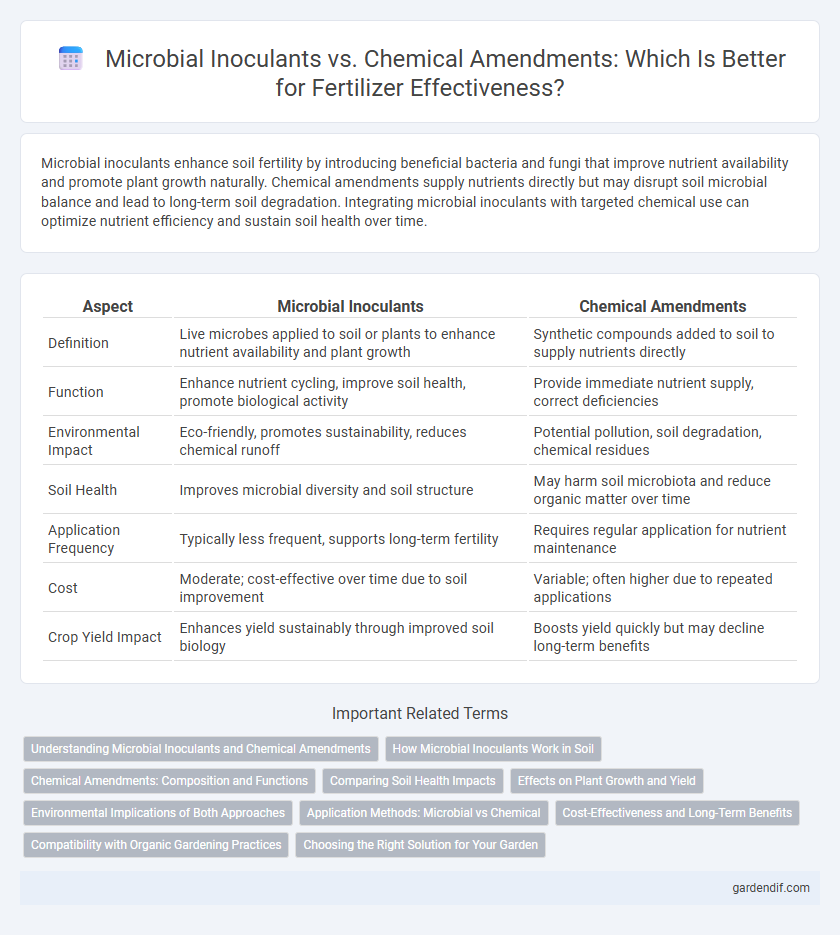
Microbial inoculants vs chemical amendments Illustration
Microbial inoculants enhance soil fertility by introducing beneficial bacteria and fungi that improve nutrient availability and promote plant growth naturally. Chemical amendments supply nutrients directly but may disrupt soil microbial balance and lead to long-term soil degradation. Integrating microbial inoculants with targeted chemical use can optimize nutrient efficiency and sustain soil health over time.
Table of Comparison
| Aspect | Microbial Inoculants | Chemical Amendments |
|---|---|---|
| Definition | Live microbes applied to soil or plants to enhance nutrient availability and plant growth | Synthetic compounds added to soil to supply nutrients directly |
| Function | Enhance nutrient cycling, improve soil health, promote biological activity | Provide immediate nutrient supply, correct deficiencies |
| Environmental Impact | Eco-friendly, promotes sustainability, reduces chemical runoff | Potential pollution, soil degradation, chemical residues |
| Soil Health | Improves microbial diversity and soil structure | May harm soil microbiota and reduce organic matter over time |
| Application Frequency | Typically less frequent, supports long-term fertility | Requires regular application for nutrient maintenance |
| Cost | Moderate; cost-effective over time due to soil improvement | Variable; often higher due to repeated applications |
| Crop Yield Impact | Enhances yield sustainably through improved soil biology | Boosts yield quickly but may decline long-term benefits |
Understanding Microbial Inoculants and Chemical Amendments
Microbial inoculants are biofertilizers containing beneficial microorganisms that enhance soil health by improving nutrient availability and promoting plant growth through natural processes. Chemical amendments, in contrast, involve synthetic substances designed to alter soil pH or supply specific nutrients directly but may not contribute to long-term soil ecosystem balance. Understanding the functional differences between microbial inoculants and chemical amendments is crucial for sustainable agricultural practices aimed at optimizing crop yield and soil fertility.
How Microbial Inoculants Work in Soil
Microbial inoculants enhance soil fertility by introducing beneficial bacteria and fungi that promote nutrient cycling, nitrogen fixation, and organic matter decomposition. These microbes improve soil structure and increase the bioavailability of essential nutrients like phosphorus and potassium to plants. Unlike chemical amendments that supply nutrients directly, microbial inoculants stimulate natural soil processes, leading to sustainable nutrient management and increased crop productivity.
Chemical Amendments: Composition and Functions
Chemical amendments primarily consist of inorganic compounds such as nitrogen, phosphorus, and potassium salts, along with secondary nutrients like calcium, magnesium, and sulfur, which enhance soil fertility and crop productivity. Their functions include correcting soil nutrient deficiencies, improving soil pH balance, and promoting faster nutrient absorption by plants. These amendments enable targeted nutrient delivery, maximizing crop yield and quality while supporting soil chemical properties.
Comparing Soil Health Impacts
Microbial inoculants enhance soil health by promoting beneficial microbial activity, improving nutrient cycling, and increasing soil organic matter, which boosts long-term fertility and structure. Chemical amendments provide immediate nutrient availability but can disrupt microbial communities and degrade soil structure over time, potentially leading to reduced soil resilience. Studies show microbial inoculants contribute to sustainable soil ecosystems, while chemical amendments often require careful management to avoid negative impacts on soil biology.
Effects on Plant Growth and Yield
Microbial inoculants enhance plant growth and yield by promoting nutrient availability, nitrogen fixation, and disease resistance through beneficial soil microbes. Chemical amendments primarily supply soluble nutrients rapidly but may lead to soil degradation and reduced microbial diversity over time. Integrating microbial inoculants supports sustainable crop productivity while maintaining soil health compared to reliance on chemical fertilizers alone.
Environmental Implications of Both Approaches
Microbial inoculants promote sustainable agriculture by enhancing soil biodiversity and nutrient cycling, reducing dependency on synthetic chemicals that often lead to soil degradation and water contamination. Chemical amendments, although effective for immediate nutrient supply, can cause long-term environmental harm through nutrient runoff and accumulation of toxic residues. Integrating microbial inoculants minimizes ecological footprints by improving soil health and reducing greenhouse gas emissions compared to conventional chemical fertilizers.
Application Methods: Microbial vs Chemical
Microbial inoculants are typically applied through seed coating, soil drenching, or foliar sprays to introduce beneficial bacteria and fungi directly to the plant root zone, enhancing nutrient uptake and soil health. Chemical amendments are often administered via granular or liquid fertilizers, which provide immediate nutrient availability but may not improve long-term soil microbial activity. Effective application of microbial inoculants requires precise timing and environmental conditions to ensure microbial viability, whereas chemical amendments rely on solubility and diffusion for plant absorption.
Cost-Effectiveness and Long-Term Benefits
Microbial inoculants offer cost-effective and sustainable improvements in soil health by enhancing nutrient cycling and promoting beneficial microbial activity, reducing dependence on expensive chemical inputs. Chemical amendments provide immediate nutrient availability but often require repeated application, increasing long-term costs and potential environmental risks. Investing in microbial inoculants delivers durable benefits such as improved soil structure and enhanced crop resilience, supporting sustainable agriculture and reducing overall fertilizer expenditure.
Compatibility with Organic Gardening Practices
Microbial inoculants enhance soil health by promoting beneficial microorganisms, making them highly compatible with organic gardening practices that prioritize natural inputs. Chemical amendments often contain synthetic compounds that may disrupt soil ecosystems and are typically excluded from organic certification standards. Utilizing microbial inoculants supports sustainable nutrient cycles and aligns with organic principles of maintaining biodiversity and ecological balance.
Choosing the Right Solution for Your Garden
Microbial inoculants enhance soil health by introducing beneficial bacteria and fungi that improve nutrient absorption and promote plant growth naturally. Chemical amendments provide immediate nutrient supplementation but may disrupt soil microbiota and lead to long-term fertility issues. Selecting the right solution depends on soil composition, plant needs, and sustainable gardening goals for optimal crop yield and environmental balance.
Microbial inoculants vs chemical amendments Infographic

 gardendif.com
gardendif.com